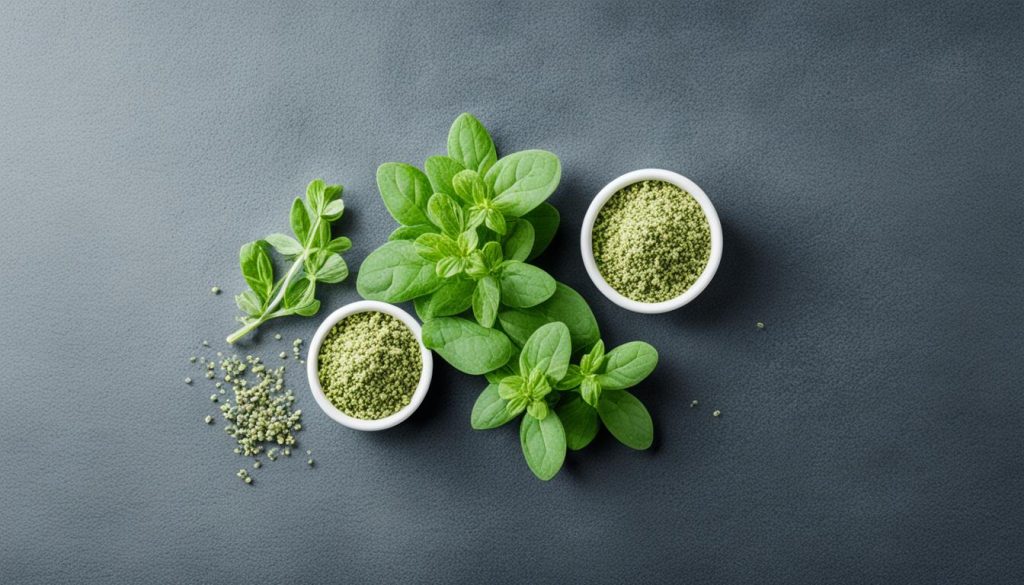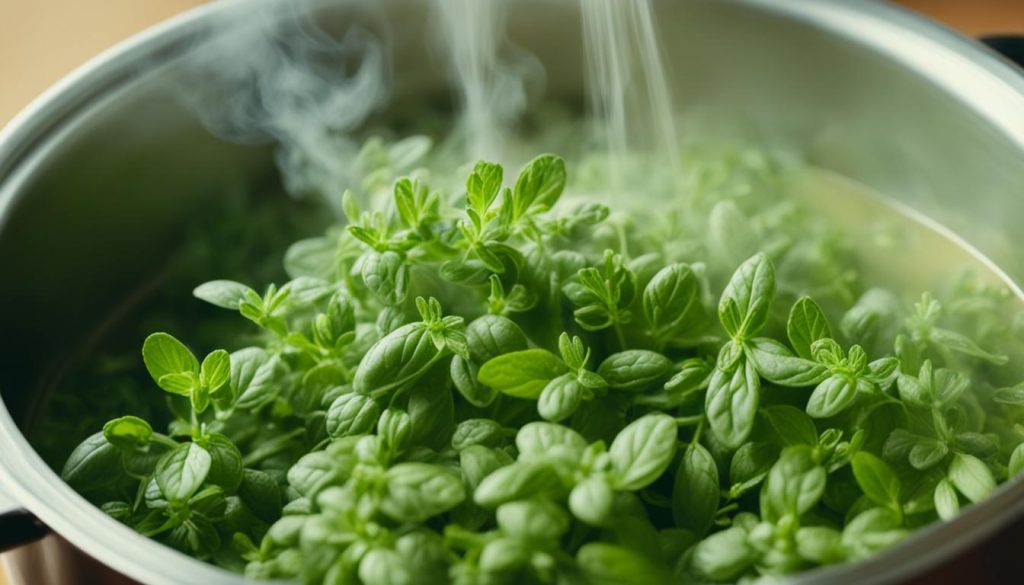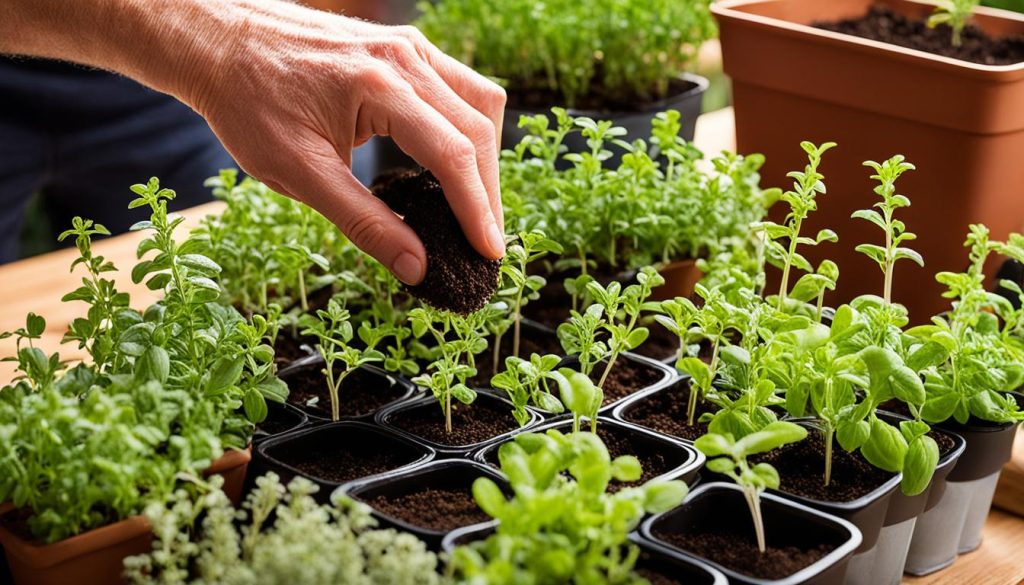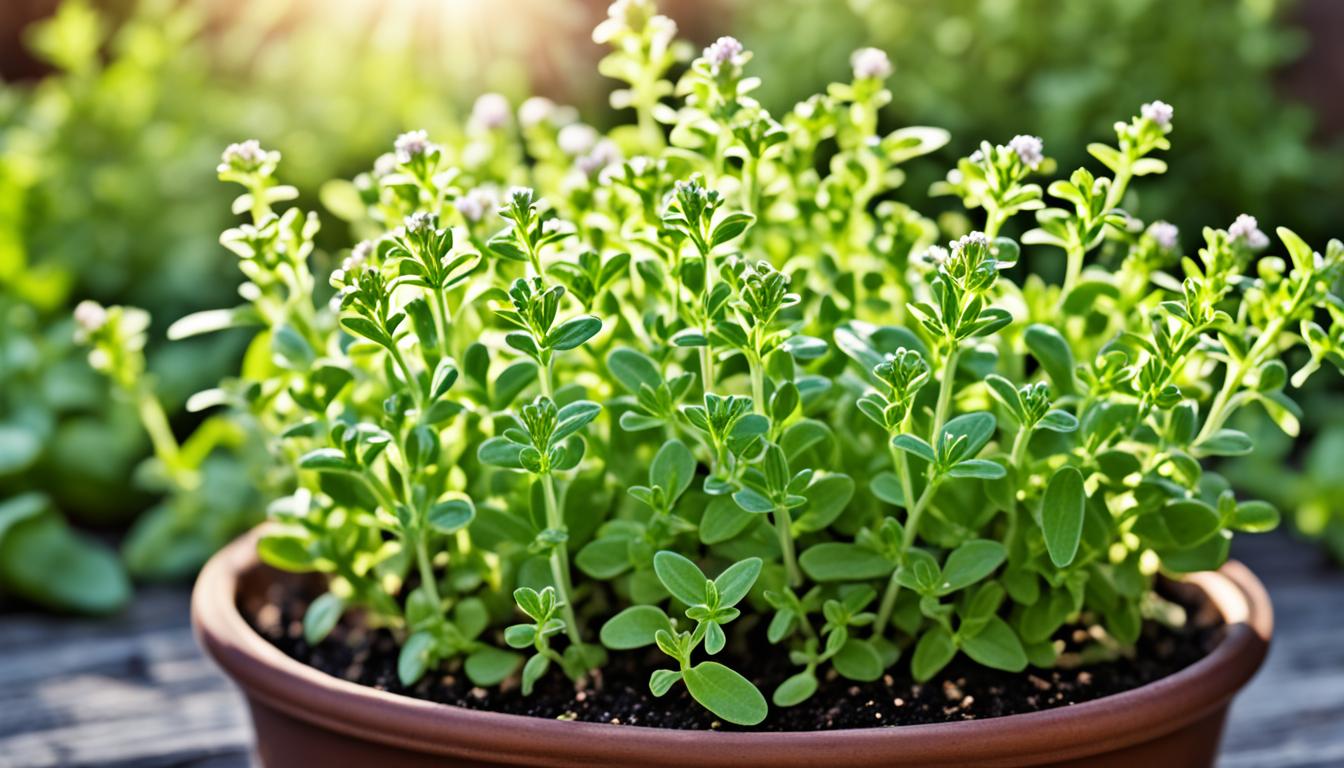I love exploring new flavors in cooking. Marjoram is an herb with a sweet, citrusy taste. It’s often overlooked but can make many dishes better. Let’s learn how to use it in cooking and its health benefits.
Marjoram has been important in Mediterranean and European cooking for a long time. It adds a special flavor to many dishes. If you want to improve your cooking or find natural health remedies, marjoram is a great choice. Let’s dive into the world of marjoram together.
Introducing the Fragrant World of Marjoram
Marjoram is a special herb that belongs to the mint family. It has a sweet, floral, and citrusy taste. This makes it a great addition to many dishes. The herb’s smell comes from terpenes like carvacrol and terpineol.
Marjoram is very useful in the kitchen. It brings out the best in Mediterranean and European dishes. It adds a special touch to food, making it more complex and sophisticated.
What Makes Marjoram a Culinary Gem?
Marjoram tastes different from oregano, its close relative. It has a lighter and more complex flavor. This makes it great for many dishes. Its sweet aroma and delicate flavor make it versatile for both savory and sweet recipes.
The Sweet Aroma and Delicate Flavor of Marjoram
- The sweet aroma of marjoram comes from its essential oils. These oils have terpenes like carvacrol and terpineol.
- The delicate flavor is a mix of floral, citrusy, and slightly minty tastes. It’s perfect with many foods.
- Marjoram can be used in both savory and sweet dishes. It’s great for Mediterranean recipes, herbal blends, and pizza seasonings.
“Marjoram’s fragrance and flavor are truly captivating, adding a touch of elegance and sophistication to any dish.”
Marjoram vs. Oregano: Understanding the Difference
Marjoram and oregano are often mixed up in the kitchen. But they are not the same. They have unique traits that make them different. Let’s explore what makes marjoram and oregano distinct for your cooking.
Oregano tastes stronger and more pungent than marjoram. It’s like “wild marjoram.” Marjoram tastes milder and sweeter. Oregano leaves are sharp, while marjoram leaves are flat.
| Characteristic | Marjoram | Oregano |
|---|---|---|
| Flavor | Mild and sweet | Robust and pungent |
| Leaf Shape | Flat and blade-like | Pointed |
| Intensity | Less intense, can be used more liberally | More intense, should be used sparingly |
Knowing the differences between marjoram and oregano helps you pick the right one for your dishes. Marjoram is great for dishes needing a light herb touch. Oregano is perfect for bold Mediterranean flavors.

“Marjoram and oregano may look similar, but their flavors are distinctly different. Choosing the right one can make all the difference in your cooking.”
Unleashing Marjoram’s Potential in the Kitchen
Marjoram is a versatile herb that can truly elevate your culinary creations. Its fragrant, slightly sweet aroma and delicate flavor are key in Mediterranean and European cuisine. It’s a must-have in many dishes, from Mediterranean recipes to pizza seasoning.
Mediterranean and European Cuisine Essentials
In Italian cuisine, marjoram adds a unique flavor to tomato sauces, pestos, and pizzas. It balances the acidity of tomatoes and the richness of cheese. In the Mediterranean, it’s a staple in dishes like Greek souvlaki and Turkish moussaka.
Marjoram in Herbal Blends and Pizza Seasoning
- Marjoram is often found in Herbes de Provence, a famous herbal blend.
- It’s also a favorite in Italian seasoning mixes, enhancing pizza, pasta, and more.
Marjoram’s uses in the kitchen are endless. It’s perfect for a Mediterranean feast or new flavor experiments. This herb adds a special touch to your dishes.
“Marjoram is the unsung hero of the herb world, adding depth and complexity to a wide range of dishes. Its ability to complement both savory and slightly sweet flavors makes it an indispensable ingredient in my kitchen.”
The Versatile Herb: Marjoram
Marjoram is a versatile herb that can add a sweet flavor to many dishes. It goes well with a lot of ingredients without taking over. It’s great in stews, braises, salads, and vegetable dishes.
Marjoram is loved for its ability to fit into many recipes. It can make a stew richer or a salad brighter. This herb can take your cooking to the next level.
| Culinary Application | How Marjoram Enhances the Dish |
|---|---|
| Stews and Braises | Marjoram’s subtle sweetness complements the savory, rich flavors, adding depth and complexity. |
| Salads and Vegetable Dishes | The herb’s delicate aroma and flavor can brighten up and refresh these lighter, healthier options. |
| Herbal Blends and Seasonings | Marjoram blends seamlessly with other herbs and spices, creating flavorful and well-balanced seasoning mixes. |
| Pizza Toppings | Sprinkled on top of pizza, marjoram adds a touch of earthy, aromatic flair to the classic dish. |
Let marjoram make your cooking better. It’s great for both new and experienced cooks. This herb adds flavor to many dishes.

Marjoram: A Powerhouse of Health Benefits
Marjoram is more than just a tasty herb. It’s packed with antioxidants and anti-inflammatory stuff. This makes it great for your health.
Antioxidant and Anti-Inflammatory Properties
Marjoram has terpenes, like carvacrol, which fight off bad free radicals. These free radicals can cause harm and increase disease risk. Marjoram also helps with inflammation. This can ease arthritis and stomach problems.
Aiding Digestion and Respiratory Health
Marjoram is good for your stomach too. Its oils relax stomach muscles, helping with digestion. It can also ease breathing problems from infections or allergies. This is because it soothes the airways.
| Health Benefit | Description |
|---|---|
| Antioxidant Properties | Marjoram is rich in terpenes like carvacrol, which act as powerful antioxidants, neutralizing harmful free radicals and reducing oxidative stress. |
| Anti-Inflammatory Effects | The herb’s anti-inflammatory properties can help alleviate conditions like arthritis and digestive issues by reducing inflammation. |
| Digestive Support | Marjoram’s essential oils can help relax the stomach muscles, promoting healthy digestion and gut function. |
| Respiratory Health | Marjoram’s potential soothing effects on the airways may provide relief for respiratory infections and allergies. |
Adding marjoram to your meals is a simple way to get its health perks. You can use it in cooking or as a tea. It’s a great choice for a healthy lifestyle.
Incorporating Marjoram into Your Diet
Adding marjoram to your meals is easy and fun. It’s a great way to enjoy its unique taste and health benefits. You can use it in many ways, not just as a seasoning.
Creative Ways to Add Marjoram to Meals
Put fresh or dried marjoram on roasted veggies for a warm, earthy taste. Or, mix it into olive oil or vinegar for tasty dressings and marinades. Sprinkle it on grilled meats and fish for a boost of flavor.
Marjoram goes great with eggs. Add it to scrambled eggs, omelets, or a fluffy frittata. It brings a delightful herb flavor to your breakfast or brunch.
Make a soothing marjoram tea for a calming drink. Its gentle, minty taste is perfect for any time of day.
Marjoram is easy to add to your cooking. It makes your meals tastier and more nutritious.

“Marjoram is a wonderful way to add depth and complexity to a wide range of dishes. Its sweet, slightly peppery notes can transform the most basic ingredients into something truly special.”
Marjoram Tea: A Soothing and Nutritious Tisane
Marjoram is a fragrant herb known for its many uses in cooking. It can also be made into a soothing tea. Drinking a warm cup of marjoram tea is a great way to enjoy its health benefits every day.
How to Prepare a Refreshing Cup of Marjoram Tea
To make a tasty cup of marjoram tea, start with a small handful of dried marjoram leaves. Heat a cup of water until it’s just simmering, then take it off the heat. Let the marjoram leaves steep in the hot water for 5-7 minutes to let the flavors come out.
After steeping, strain the tea to get rid of the leaves. You can make it even better by adding a bit of honey or some nutmeg. These add to the marjoram tea’s mild, sweet taste. Enjoy the warm, soothing taste of this marjoram tea.
“Sipping on a warm cup of marjoram tea is a simple yet effective way to incorporate this versatile herb into your daily routine and reap its potential health advantages.”
Marjoram tea is full of antioxidants and can help with many health issues, such as:
- Aiding digestion
- Supporting respiratory health
- Promoting stress relief
If you want to relax or just enjoy a tasty, healthy drink, marjoram tea is a great pick.
Cultivating Marjoram: Growing Your Own Herb Garden
Gardening lovers, get excited! Growing your own marjoram is rewarding. This herb loves sunny spots with good drainage. It’s perfect for your garden. You can start with seeds or young plants. With care, you’ll have lots of this tasty herb all year.
Planting and Caring for Marjoram
Marjoram likes soil that’s a bit alkaline and needs regular water, especially in summer. Make sure it gets lots of sunlight to grow well and give lots of leaves. After it starts growing, marjoram is tough and keeps giving you this tasty herb.
- Choose a sunny, well-drained spot for your marjoram plants
- Water the plants often, especially when it’s dry
- Feed your marjoram a bit every few months to help it grow
- Trim the plants often to make them bushy and stop them from flowering
Follow these easy steps to grow a great herb garden with marjoram. Use the fresh leaves in cooking or dry them for later. Growing marjoram at home means you always have this useful herb on hand.

“Marjoram is one of the most versatile herbs in the kitchen, and growing it yourself is a true joy.”
| Growing Conditions | Ideal Soil pH | Sunlight Requirements | Watering Needs |
|---|---|---|---|
| Well-drained, sunny locations | Slightly alkaline (6.0-7.5) | Full sun (6-8 hours per day) | Regular watering, especially in hot weather |
Precautions and Potential Side Effects of Marjoram
Marjoram is usually safe and useful. But, it’s good to know a few things before using it. Some people might be allergic to marjoram and could get skin irritation or stomach upset. Pregnant and nursing moms should be careful and use it in small amounts.
Marjoram might also affect some medicines, like blood thinners or diabetes drugs. If you’re on any medicines, talk to your doctor before adding marjoram to your diet. This helps keep you safe and avoids bad reactions.
When using marjoram essential oil, make sure to mix it with something before putting it on your skin. The strong form can be too harsh. Always check the label and test a small area first.
Being careful helps you enjoy marjoram’s good points safely. If you have bad reactions or have questions, talk to a health expert.
“Moderation is the key when it comes to using any herb, including marjoram. As long as you’re aware of potential sensitivities and interactions, you can safely incorporate this versatile herb into your diet and lifestyle.”
Marjoram: A Timeless Culinary Companion
Marjoram has been a key ingredient in Mediterranean and European cooking for a long time. It adds a sweet, fragrant taste to many dishes. This makes it a must-have for home cooks everywhere.
Marjoram is not just tasty; it’s also good for you. It has antioxidants and anti-inflammatory properties. These can help with digestion and breathing. Adding marjoram to my meals means I get to enjoy great flavors and health benefits.
Marjoram is loved for its many uses in cooking. It’s great for adding flavor to dishes or making tea. This herb is always a source of new ideas in the kitchen and can be good for my health.

